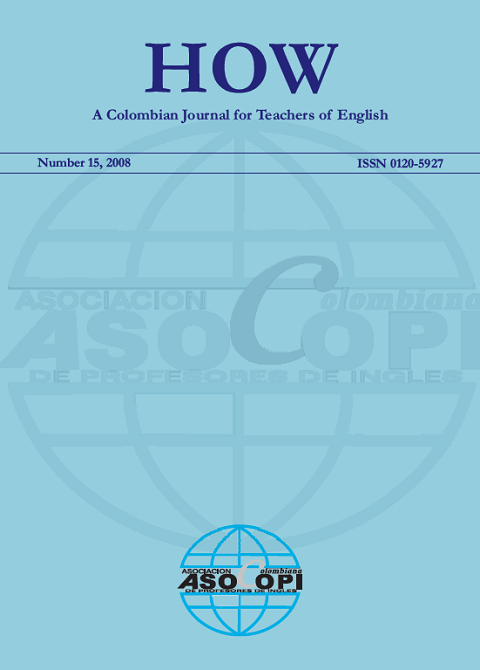Tratamiento de los errores durante la enseñanza del inglés como segunda lengua: un balance entre forma y contenido
Contenido principal del artículo
Resumen
Detalles del artículo
Los contenidos de la revista HOW se publican bajo la licencia Creative Commons Atribución-NoComercial-SinDerivar 4.0 Internacional. Usted es libre para copiar y redistribuir el material en cualquier medio o formato siempre y cuando usted otorgue el crédito de manera apropiada. Usted no puede hacer uso del material con fines comerciales. Si usted mezcla, transforma o crea nuevo material a partir de esta obra, usted no podrá distribuir el material modificado. Más información: http://creativecommons.org/licenses/by-nc-nd/4.0/deed.es.
Se solicitará a los autores cuyos artículos se aceptan para publicación en HOW que firmen una cesión de derechos no exclusiva con el fin de permitir a ASOCOPI reproducir el texto completo en el internet o en cualquier otro medio disponible. Los autores conservan los derechos sobre sus manuscritos con las siguientes restricciones: el derecho de primera publicación es otorgado a ASOCOPI; los autores pueden establecer acuerdos no exclusivos con terceros siempre y cuando la publicación original en la revista HOW sea reconocida adecuadamente.
Citas
Allwright, D., & Bailey, K. M. (1991). Focus on the language classroom. Cambridge, U.K.: Cambridge University Press.
Bloomfield, L. (1933). Language. Chicago: University of Chicago Press.
Brown, H. D. (2000). Principles of language learning and teaching (4th ed.). New York: Longman.
Chastain, K. (1976). Developing second language skills: Theory to practice (2nd ed.). Boston: Houghton Mifflin.
Corder, S. P. (1981). Error analysis and interlanguage. Oxford: Oxford University Press.
Crystal, D. (1987). The Cambridge encyclopedia of language. Cambridge: Cambridge University Press.
Cummins, J. (1999). Beyond adversarial discourse: Searching for common ground in the education of bilingual students. In C. J. Ovando & P. McLaren (Eds.), The politics of multiculturalism and bilingual education: Students and teachers caught in the cross-fire (pp. 126-147). Boston: McGraw-Hill.
Ellis, R. (1994). The study of second language acquisition. Oxford: Oxford University Press.
Gabrielatos, C. (1994). Minding our ps. Current Issues, 3, 5-8. Retrieved July 25, 2008, from http://www.gabrielatos.com/PPP.pdf
Gabrielatos, C. (2002). EFL writing: Product and process. (ERIC Document Reproduction Service No. ED476839). Retrieved December 16, 2008, from ERIC database.
Giraldo, M. C., & Perry, R. A. (2005). Treating writing errors of low-to-intermediate EFL university students. Unpublished master’s thesis, Universidad de Caldas, Colombia.
Gray, R. (2004). Grammar correction in ESL/EFL writing classes may not be effective. The TESL Journal, X (11). Retrieved July 25, 2008, from http://iteslj.org/Techniques/
Gray-WritingCorrection.html
Hodges, J. C., & Whitten, M. E. (1972). Harbrace college handbook (7th ed.). New York: Harcourt Brace Jovanovich.
Krashen, S., & Terrell, T. (1983). The natural approach: Language acquisition in the classroom. Hayward, CA: The Alemany Press.
Lyster, R., Lightbown, P. M., & Spada, N. (1999). A response to Truscott’s “What’s wrong with oral grammar correction”. Canadian Modern Language Review, 55 (4), 456-467.
Mahili, I. (1994). Responding to student writing. English Teaching Forum, 32 (4), 24-27.
Mantello, M. (1997). Error correction in the L2 classroom. Canadian Modern Language Review, 54 (1), 127-132.
Pakula, A. J. (Producer), & Mulligan, R. (Director). (1967). Up the down staircase [Motion picture]. U.S.A.: Warner Bros.
Porte, G. K. (1993). Mistakes, errors, and blank checks. English Teaching Forum, 31 (1), 42-44.
Quiroga, A., Jiménez, H., & Rojas, G. (2001). La enseñanza de la lengua materna en el Caquetá: Estado actual y alternativas de transformación. Florencia, Caquetá: Universidad de la Amazonía, Colciencias, BID.
Real Academia Española. (1973). Esbozo de una nueva gramática de la lengua española. Madrid: Espasa
Calpe. Reid, J. M. (1993). Teaching ESL writing. Englewood Cliffs, NJ: Prentice Hall.
Rivera, K. (1990). Developing native language literacy in language minority adults. Washington D.C.: National Clearinghouse on Literacy Education. (ERIC Document Reproduction Service No. ED358747). Retrieved July 25, 2008, from ERIC database.
Simpson, JoEllen. (2003). Responding to our students’ writing: what is good for us and for them? HOW, 2003 issue, Vol. 10, pp. 45-52
Truscott, J. (1999). What’s wrong with oral grammar correction. Canadian Modern Language Review, 55 (4). Retrieved August 6, 2005, from http://www.hss.nthu.edu.tw/~fl/faculty/John/What%27s%20Wrong%20with%20Oral%20Grammar%20Correction%201999.htm
Truss, L. (2003). Eats, shoots and leaves. The zero tolerance approach to punctuation. London, U.K.: Profile Books.
Wright, T. (1987). Roles of teachers and learners. Oxford: Oxford University Press.

